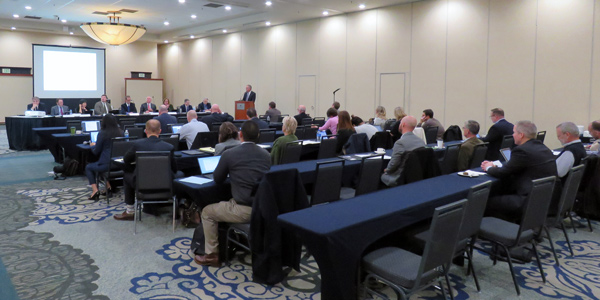By Jason Fordney
BOISE, Idaho — Decision-makers for the Western Energy Imbalance Market (EIM) last week approved a set of market initiatives that represents a narrowed-down version of a package CAISO proposed to market participants earlier this year.
The EIM Governing Body on Nov. 29 unanimously approved CAISO’s “consolidated EIM initiatives,” which will automate some manual processes, facilitate bilateral settlements and improve the market’s modeling accuracy.
CAISO Senior Adviser Don Tretheway briefed body members on the three aspects of the proposal over which they had decisional authority. In a presentation, he explained that one measure allows auto-matching of balancing changes in intertie schedules between an EIM resource and a non-EIM resource, allowing a member to use the external resource to “self-balance” an intertie change.
The initiative also automates the updating of mirror system resources at CAISO intertie scheduling points, which is done to prevent imbalances. Those resources allow the market to solve for the ISO and another EIM area at the same time.
“Currently, EIM entities are responsible for manually updating this mirror system resource,” Trethaway said, noting that the manual process is subject to error or delays.
A third aspect of the approved initiative supports imbalance settlement of EIM base transfer schedule changes. That measure will facilitate bilateral scheduling between EIM entities, allowing settlement of energy transfers at agreed-upon financial locations for bilateral schedule changes occurring after base schedules are submitted.
In September, CAISO announced it was dropping several aspects of the consolidated EIM initiatives because of negative feedback from stakeholders. (See CAISO Drops Proposed EIM Changes.) One proposal would have allowed non-EIM third-party transmission owners to provide transfer capacity in the market, while another adjusted management of bilateral schedule changes. A third measure would have ensured payments to EIM entities that currently don’t get compensation for wheeling power through their balancing areas.
Chairman Douglas Howe clarified with Tretheway that third-party transmission providers would reduce their own congestion revenue by providing the increased capacity to the EIM “and work against” their own interests.
“Is this really a feasible initiative at all?” Howe asked. Tretheway replied that it might be workable in certain cases with EIM transfers.
The disincentive was an issue raised by stakeholders during review of the proposal, leading it to be dropped from the initial package. (See CAISO Drops EIM Third-Party Transmission Plan.)
The Governing Body last week also gave advisory approval to separate rule clarifications for CAISO’s non-generator resources (NGR) market enhancement, which allows new types of resources (such as storage) to participate in the ISO’s regulation market. Powerex is using NGR to model its participation in the EIM, and the ISO said the changes provide additional clarity on market rules for NGR — including clarifying that such resources are subject to local market power mitigation and are not eligible to account for resource adequacy capacity.
“This is something that you would be doing irrespective of whether the EIM existed?” Howe asked, which Tretheway confirmed.





